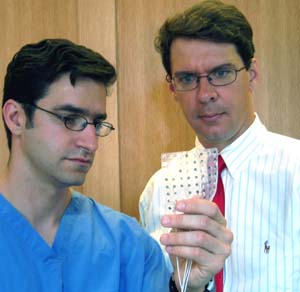For the first time in humans, a team headed by University researchers has placed an electronic grid atop patients’ brains to gather motor signals that enable the patients to play a computer game using only the signals from their brains.
The use of a grid atop the brain to record the organ’s surface signals is a brain-machine interface technique that uses electrocorticographic (ECoG) activity — data taken invasively directly from the brain surface. It is an alternative to the status quo, used frequently when studying humans, called electroencephalographic activity (EEG) — data taken noninvasively by electrodes on the skull.

The breakthrough is a step toward building biomedical devices that can control artificial limbs, enabling the disabled to move a prosthetic arm or leg just by thinking about it. The study was published in the June 8 issue of the Journal of Neural Engineering and was partially funded by the National Institutes of Health.
Eric C. Leuthardt, M.D., a WUSTL neurosurgeon at Barnes-Jewish Hospital, and Daniel Moran, Ph.D., assistant professor of biomedical engineering in the School of Engineering & Applied Science, performed their research on four adult epilepsy patients who had the grids implanted so that neurologists could find the area in the brain serving as the focus for an epileptic seizure, with hopes of removing it to avoid future seizures. To do this, the patients and their doctors must wait for a seizure.
With approvals from the patients and the School of Medicine Institutional Review Board, Leuthardt and Moran connected the patients to a sophisticated computer running a special program known as BCI2000 (developed by their collaborators at the Wadsworth Center, a state health laboratory in New York) that involves a video game linked to the ECoG grid.
They then asked the patients to do various motor and speech tasks, moving their hands various ways, talking and imagining. Members of the team could see from the data which parts of the brain correlate to these movements.
They then asked the patients to play a simple, one-dimensional computer game involving moving a cursor up or down toward one of two targets.
Patients were asked to imagine various movements or imagine saying the word “move,” but not to actually perform them with their hands or speak any words by mouth.
When they saw the cursor in the video game, they then controlled it with their brains.
“We closed the loop,” Moran said. “After a brief training session, the patients could play the game by using signals that come off the surface of the brain. They achieved between 74 and 100 percent accuracy, with one patient hitting 33 out of 33 targets correctly in a row.”
The ECoG method takes much less time to learn than the original EEG.
“It takes many months to train using EEG, whereas our approach was done basically in an hour or so,” Moran said. “That’s because we got the signals from the surface of the brain rather than having to go through the skull.”
“To put this in perspective,” Leuthardt said, “the previous EEG-based systems are equivalent to a 1908 Wright brothers airplane in regards to speed of learning to achieve control. Right now, with our results, we’re flying around in an F-16 jet.”
The two note that ECoG has higher spatial resolution, broader bandwidth and higher amplitude than the EEG approach, allowing the use of more electrodes and the gain of higher frequencies, which let the researchers go another step — they tried it out on a 2-D game and were able to predict where the patients would move by seeing which electrodes were active on the grid. However, this group of patients did not control movement in the 2-D game with their brains as the patients had with the 1-D game.
The researchers next want to try patients out with 2-D games to see if they can control the movements with their brains.
They will also implant the ECoG grids into monkeys to see how long they can get reliable data from them, the goal being eventually to develop a brain-machine interface device that will last perhaps up to 10 years, making the choice to have one implanted into a motor-impaired patient’s brain practical.
“We are pretty confident that we can get signals from these for many years,” Moran said. “There will have to be a rigorous study on monkeys for an indeterminate number of years before we can consider permanent implants in human subjects, but we’re really excited about this advance.
“Brain-computer interface research is one of the hottest things going in biomedical engineering today.”
“Our work,” Leuthardt said, “has significant clinical relevance to potentially improve the lives of people with such disabilities as ALS and spinal cord injuries. Additionally, this type of re-search is producing some fundamental insights into myriad different fields, ranging from neurophysiology to clinical medicine.”
Collaborators on the study were Gerwin Schalk and Jonathan R. Wolpaw, M.D., of the Wadsworth Center, New York State Department of Health, Albany, N.Y.; and Jeffrey G. Ojemann, M.D., of the University of Washington School of Medicine.